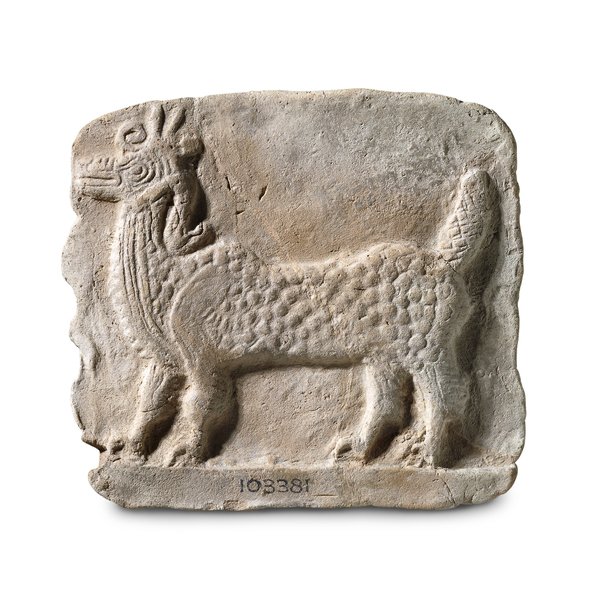لوح من الطين الأحمر لتنّين
Terracotta plaque of a dragon
لوح من الطين الأحمر لتنّين
العصر البابلي الحديث، حوالي 800-550 ق.م.
من بلاد ما بين النهرين
هذا اللوح الطيني يماثل تقريبا الصورة العامّة للأشومكال، الأفعى التنّين في الشعر السومري. الأشومكال ربّما يكون تعبيرا مجازيّا عن الإله أو الملك؛ و ليس بالضرورة أن يكون شرّيرا أو غير سار.
للأفعى التنّين قرون و جسم و رقبة أفعى و أرجل أماميّة لأسد و سيقان خلفيّة لطائر. و هي تمثّل في الفن منذ 2300 ق.م. و حتّى القرون الأخيرة من ما قبل الميلاد كرمز للعديد من الآلهة أو ككائن هجين سحري حامي. و قد تمّ تشخيصه على أنّه الموشخششّو الأكدي أو الثعبان العنيف. و يشتهر على أنّه مخلوق مردوخ، كبير آلهة بابل. و عندما تمّ إحتلال بابل من قبل الملك الآشوري سنحاريب "الذي حكم من 704-681 ق.م." تمّ جلب النحت لبلاد آشور ليصبح الرمز الوحشي لإله دولة آشور.
المتحف البريطاني - لندن
////////////////////////////////////////////////////////////////////////////
Terracotta plaque of a dragon
Babylonian, about 800-550 BC
From Mesopotamia
This clay plaque closely corresponds to the general image of the ushumgal, the 'snake-dragon' of Sumerian poetry. The ushumgal can be a metaphor for a god or king; and is not necessarily evil or unpleasant.
The snake-dragon has horns, the body and neck of a snake, the forelegs of a lion, and the hind legs of a bird. It is represented in art from 2300 BC to the last centuries BC as a symbol of various gods or as a magically protective hybrid. It has been identified as the Akkadian mushhushshu or 'furious snake'. It is best known as the creature of Marduk, the god of Babylon. When Babylon was conquered by the Assyrian king Sennacherib (reigned 704-681 BC) the motif was brought to Assyria as a symbolic beast of the state god Ashur.
The British Museum - London
Check: http://www.britishmuseum.org/explore..._a_dragon.aspx
للمزيد الرجاء الأطلاع على // for more please visit
:: سلسلة أثريات ولوحات من بلادي ::







 رد مع اقتباس
رد مع اقتباس
